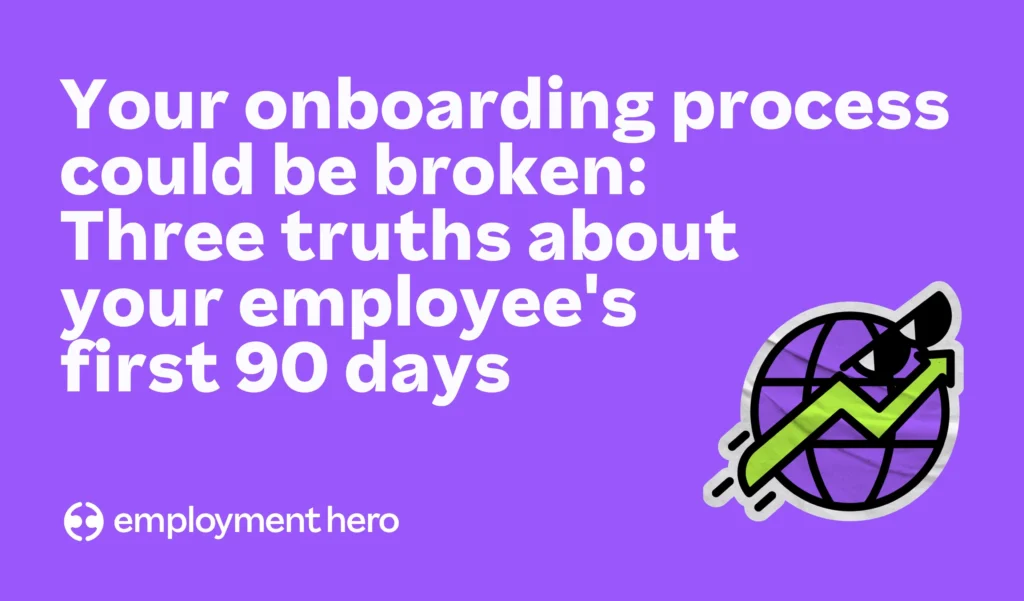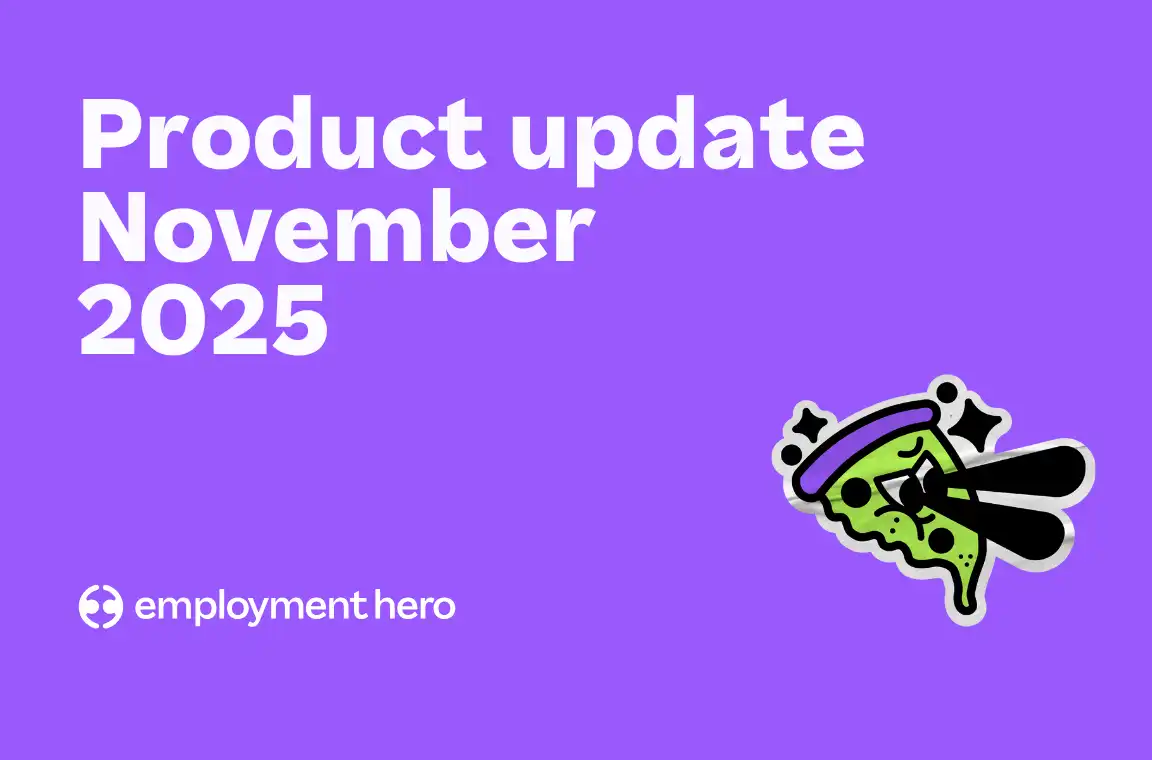Your onboarding process could be broken: Three truths about your employee’s first 90 days
We’ve wrapped up the benefits of switching from promoting a culture of work-life balance to building a culture of work-life integration (and all of the hidden costs you could come up against if you don’t).

Contents
Think back to the last time you onboarded a new hire and felt genuinely confident in the process. Were they set up for success? Did they have everything they needed to hit the ground running? And did they stay running?
While you might feel confident that your onboarding process is ticking all of the right boxes, the real test happens in your employee’s first 90 days.
Far too often, the “comprehensive onboarding experience” translates to an overwhelming flood of welcome emails, forgotten checklists, and back-to-back meetings with little-to-no context. And the last thing you want is to hand out the lanyard, share the logins and leave your new hire being left to figure it out alone.
In a hiring market where top talent can afford to be picky, a disjointed and mediocre onboarding experience can be the reason a great hire becomes a short-term one.
If any of this sounds uncomfortably familiar, this one’s for you. Use it as your sign to recognise the gaps and take the first step to fixing them. We’re breaking down the hidden costs of poor onboarding, three brutal truths about your process and what you can do to set your new hires up for success in the first 90 days.

The hidden costs of a poor onboarding experience
Every hiring manager knows that hiring is hard work. You spend weeks or months writing the perfect job ad, reviewing cover letters and CVs, scheduling interviews, taking notes, making offers and then finally, you find the one. It’s a win for everyone… until it isn’t.
Because just days after joining, your new hire quietly pulls the pin before they’ve even unpacked their desk. Suddenly, you’re back where you started. Blind-sided, out of pocket, down a team member and wondering where it all went wrong.
If you’ve felt that onboarding sting, you’re not the only one. It’s happening far more than most Aussie small to medium-sized enterprises (SMEs) realise. The reality is that many new hires are walking away from their new job faster than they walked in.
Our Hiring Snapshot Report revealed that 27% of respondents had a new hire leave the business within their first six days and 22% had a new hire leave within 1-2 weeks. 60% had a new hire leave within the first month, and 78% stated they’ve had someone leave within the first three months. With the average hiring spend sitting at $13,545 per year, that’s a lot to spend for nothing in return.

For small businesses, the blow hits even harder. If you’re not using SmartMatch, there’s no one waiting in the wings ready to fill the role at a moment’s notice and no bench of backups ready to sub in. This means that every new hire that doesn’t work out results in lost time, lost money and even more pressure on your already thinly-stretched team.
When you step back, it could be that your onboarding process (or lack thereof) is to blame.
If you bring a new team member on board and they don’t feel supported or welcomed, it’s likely they’ll be questioning if it was the right move for them. And they’ll be ready to jump somewhere else as soon as the opportunity presents itself.
So, if you’re resonating with this more than you’d like to admit, take it as a sign to review your onboarding process, but not before we share our 3 brutal truths that contribute to a poor onboarding experience.
Truth #1: Your workplace culture isn’t as clear as you think
Chances are, you’ve spent years creating and building your workplace culture. But if you’ve just finished onboarding a new hire and they can’t explain it to you by the end of the first week, you’ve got a bigger problem on your hands.
For new employees, it’s likely they’ll have a basic idea of what your workplace culture is like when they accept the job (and it’s probably a big part of why they said yes). They’ll also be looking to see if what they’ve been told in the recruitment process matches up once they’re on the job.
They’ll look at the vibe in meetings, watch how people interact in those casual water-cooler moments and how people generally engage with one another. And if their observation doesn’t match the values and culture you spoke through in the interview process, things can start to go downhill quickly.
To make sure a culture mismatch isn’t happening in your business during recruitment and onboarding, you need to go back to basics. Think about all of the key elements that make up your team, processes, values, goals and what you stand for as a business.
From here, you can start to weave in these elements throughout your onboarding process. Invite new starters to get involved in team rituals, showcase real-life employee stories that reflect what you stand for as a business, and let them buddy up with people who live those values every day.
Actionable tips you can introduce in your onboarding to allow new starters to embrace your workplace culture
- Create a buddy system: Match every new hire with a buddy. This should be someone outside of their direct team who can help answer questions, offer support, and give insight into what it’s really like at your company.
- Share the company story: Host a short session on your company’s mission, values and founding story. To make it more impactful, have the founder or a member of senior leadership share this.
- Walk through the values and share how they’re practiced in real-time: Seeing workplace values in action is 100x more impactful compared to reading a document with them listed out. Give examples of how they shape the everyday and some standout moments of people living them.
- Book team introductions: Set up quick 1:1s with key people across the business, so your new hire can meet key people and understand how they’ll be working together.
- Celebrate early wins: Your new starter is still learning the ropes, which is why it’s important to publicly acknowledge their contributions in the first few weeks. Reinforces what great work looks like and how you value their contribution from day one.
- Ask for feedback: At the two-week mark, ask for feedback. Consider asking questions like, “What’s surprised you so far?” and “What’s been unclear?”. This opens the floor for honest feedback and fast improvements to be made during onboarding.

Truth #2: You’re cramming a 90-day process into 30
We all know just how easy it is for onboarding plans to fall off a cliff after the first few weeks of your new hire starting.
You roll out the red carpet in their first week, make a couple of check-ins in their second week and by day 30, in your eyes, your new starter has a handle on the basics and you accept that’s good enough. But your new hire? They’re still figuring out how things work, who to go to for what, and all of the other things that take far longer than just one short month to grasp.
If your onboarding plan stops at 30 days, you’re only solving one-third of the task at hand. Without ongoing structure and regular feedback, your new hires have the potential to disengage, feel isolated or not be crystal clear on what success looks like. And when that happens, they leave, or even worse, they stick around but check out.
Instead, you need to shift your thinking from short-term to long-term.
The crux of every great onboarding experience should be structured around key points in time, such as 30, 60 and 90 days. Each stage should be built on the last, and your new starter should feel their confidence grow in every part of their role, every day.
You need to provide a proper structure, along with the right tools to set them up for success. Use our framework below to help guide your onboarding plan.
Breaking down a 30-60-90 day plan
Think of your 30-60-90 day plan as your new starters roadmap to onboarding success. It clearly outlines their first three months, along with expectations, into clear and specific tasks.
|
Timeframe |
Focus |
Key actions and goals |
|---|---|---|
|
First 30 days |
Learn and understand |
Get familiar with company culture, policies, team members, and role expectations. Complete essential training and onboarding tasks. Start building relationships internally. |
|
Next 30 days (days 31-60) |
Apply and contribute |
Begin taking on responsibilities with guidance. Start contributing to projects and collaborate cross-functionally. Seek feedback regularly to improve. |
|
Final 30 days (days 61-90) |
Own and improve |
Take full ownership of role duties. Deliver measurable outcomes aligned with business goals. Identify opportunities for continuous improvement and growth. |
Truth #3: Your onboarding doesn’t include measures of success for the role
If you’re onboarding people in the business without clear performance indicators, you’re doing the opposite of setting them up for success. And when employees are left guessing, that’s where the cracks can begin to show.
That’s why you need to design an onboarding process that’s intentional, so you avoid falling into the onboarding orientation trap. A tour of the office, a couple of introductory meetings and a few links to training videos is nice, but it doesn’t include any clear metrics. You need to provide indicators of what success looks like in the role at key points in time, as well as how they can see if they’re on track. If you’re in need of some inspiration, take a look at our in-depth guide on Objectives and Key Results (OKRs).

Without defined targets or role-specific goals in those critical early months, new starters are left in the dark. They don’t know what to prioritise, what to measure themselves against, or how to demonstrate that they’re progressing. And for managers, it becomes harder to spot issues early, provide meaningful feedback or coach for improvement if things aren’t going the way it was hoped.
Thankfully, there’s an easy solution that you can easily include in your 30-60-90 day plan. When pulling the plan together, embed performance metrics that are specific to the role. Set SMART goals for each milestone, as well regular check-ins for overall learning progress. Adopt an iterative approach and use your check-ins to measure against these and adjust where needed.
When employees know what’s expected and how they’ll be supported, they’re far more likely to hit the ground running and stick around for the long-term.
Don’t fall victim to a broken onboarding process that’s quietly costing you top talent
It’s no secret that onboarding is one of the most critical parts of your new hire’s journey with your company. The first 90 days are make-or-break, so getting right is everything.
But when your onboarding process is broken, you run the risk of top talent quietly slipping through your fingers before they’ve had a real chance to make an impact.
The good news is that with smarter planning, regular check-ins, and a genuine focus on engagement, you can fill in those gaps and make onboarding one of your strongest tools for attracting and keeping great people.
Frequently Asked Questions
Onboarding is the structured approach that helps new hires transition smoothly into their new role. It includes all of the important paperwork and documents, like contracts and polices and entitlements.
When done well, it clearly sets clear expectations, introduces key processes, and gives new employees the relevant resources and tailored support they need to hit the ground running. A strong onboarding process makes sure new team members understand their job description, the company’s mission, and how their work aligns with broader company goals.
A well-designed onboarding process can set the tone for the entire employee experience of a new hire. In this process, it focuses on your new hire building relationships, collaborating with others and connecting to your company culture.
If you’re looking for more information, download our in-depth guide on creating a standout onboarding process.
A 90 day onboarding plan breaks down the initial period of a new hire’s journey into manageable phases, typically focused on learning, applying, and owning their new role. This plan often includes SMART goals tied to key performance indicators (KPIs), helping new employees track progress and build confidence.
The 90 day plan encourages regular check-ins and one on one meetings with the hiring manager or new manager to ensure clear expectations and continuous feedback. This time-bound, strategic roadmap supports new hires in understanding their key tasks, building relationships with key stakeholders, and delivering measurable progress aligned with company goals.
Improving your onboarding process means creating a strategic plan that includes realistic goals, tailored support, and opportunities for relationship building. Start with a solid 30-60-90 day plan that outlines clear success metrics and performance goals for the new role. Incorporate training sessions and team meetings to immerse your new team members in the company’s culture and key processes.
Consistent goal setting, regular check-ins, and gathering feedback can create valuable insights that help refine the process and boost employee retention. Remember, onboarding is an essential part of supporting new employees through their entire initial period to ensure they accomplish early wins and fully integrate into the team.
Employment Hero offers tools designed to simplify and supercharge your onboarding process. With features like customised onboarding checklists, goal setting frameworks like OKRs and automated workflows, you can create a consistent experience that aligns with your company’s mission and team priorities.
Our Employment Operating System also helps you measure success with detailed reports on employee’s goals and performance metrics, giving you valuable insights to continuously improve your new hire’s onboarding and boost overall employee retention.
If you want to learn more about how we can support your onboarding, watch our quick demo or get in touch with one of our business specialists.
Related Resources
-
 Read more: PEO vs. EOR: A guide to global hiring
Read more: PEO vs. EOR: A guide to global hiringPEO vs. EOR: A guide to global hiring
Learn the key differences between a PEO and an EOR. Discover why an EOR is the smarter, safer way to…
-
 Read more: Product Update: November 2025
Read more: Product Update: November 2025Product Update: November 2025
Welcome to the November 2025 product update from the Employment Hero team. We’ve got lots to share around Workflows, Rostering,…
-
 Read more: Record keeping requirements Australia: What every employer needs to know
Read more: Record keeping requirements Australia: What every employer needs to knowRecord keeping requirements Australia: What every employer needs to know
Learn the record keeping requirements for businesses in Australia. Understand what records you must keep, how long to keep them…























